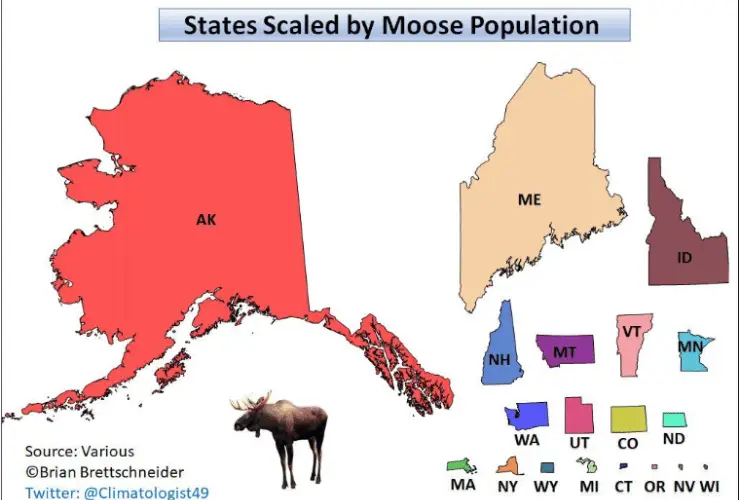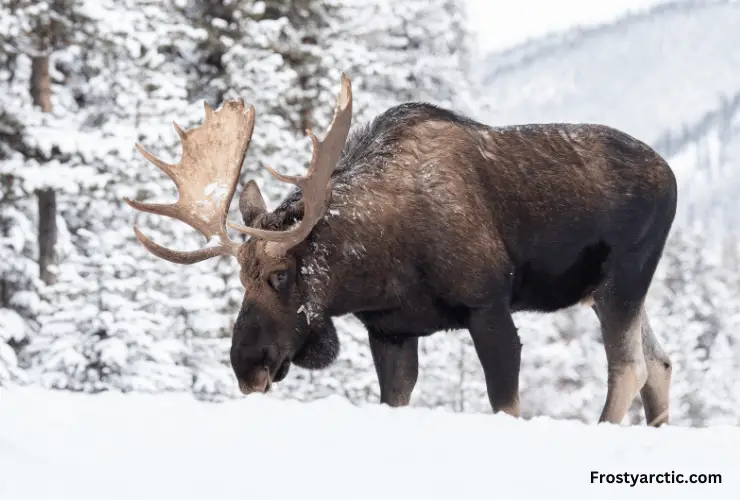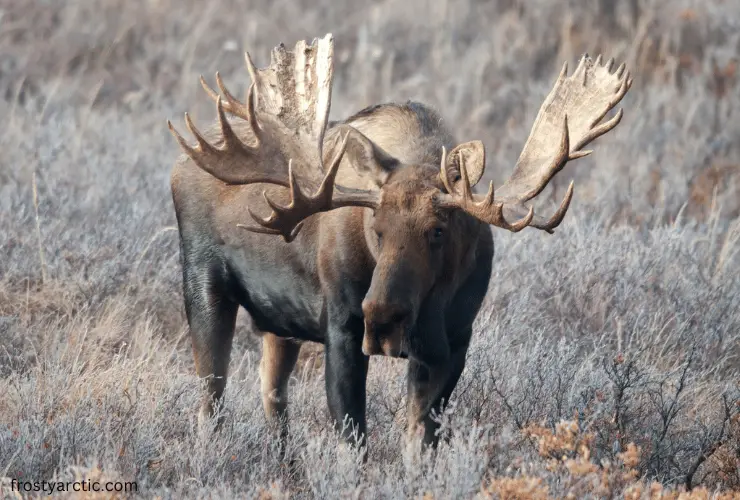Yes! Moose can be found in Colorado. According to a study in 2014, a total of 2,400 moose were found in Colorado. The present statewide moose population reaches 3000. ~Source.
While the moose population in other states has declined, Colorado’s moose population continues to grow. However, the moose population in Colorado is not considered autonomous and the state’s wildlife management agency closely monitors the population.
Are There Moose in Colorado?
Moose are not native to Colorado and were not historically found in the state. However, in recent years there have been occasional moose sightings in Colorado, particularly in the northern and central regions of the state.
These sightings are believed to result from moose migrating south from neighboring states such as Wyoming, where moose populations are more established.
The number of moose in Colorado is still being determined, but their population is small and needs to be established.
The Colorado Parks and Wildlife (CPW) has been monitoring the moose population in the state and has reported that the number of moose sightings has increased in recent years.
However, it is important to note that just because there are more moose sightings does not necessarily mean that the population is growing.

The CPW has stated that moose in Colorado may be facing challenges such as a lack of suitable habitat and potential competition with other ungulates, such as elk and deer, for food resources.
Additionally, Colorado’s warm and dry climate may also be a factor in the moose’s ability to thrive in the state.
It is important to note that if you spot a moose in Colorado, it is best to view them safely and give them plenty of space. Moose are large and powerful animals that can be dangerous if they feel threatened.
Highlights of Moose Reintroduction in Colorado
| Year | Number of Moose Reintroduced |
| 1978 | 24 (12 from Wyoming and Utah each) |
| 1987 | 12 (From Wyoming) |
| 1991-1993 | 93 (From Wyoming and Utah) |
| 2009-2010 | 39 (19 From Utah and 20 from North Park) |
Moose have been reintroduced in Colorado from time to time. The first reintroduction was in 1978 when 24 Moose were brought in from Wyoming and Utah.
The second reintroduction was in 1987 when 12 Moose were brought in from Wyoming. The next reintroduction after this was in 1991-1993, with 93 Moose coming in from Utah and Wyoming.
The last introduction was in 2009-2010, with 39 Moose, 19 from Utah and 20 from North Park, being brought in.
| Year | Moose population in Colorado |
| the 1950s | 0 (Officials considered bringing Moose to Colorado) |
| 1960s and 1970s | 0 (Officials worked with other departments to bring Moose) |
| 1978 | 24 (12 Male and 12 Female) |
| 2012 | 2,300 |
| 2014 | 2,400 |
| 2018 | 3200 |
It was back in the 1950s when Colorado wildlife officials considered bringing Moose to Colorado. Many concerns were laid out about Moose possibly damaging the local ecosystem, but in the end, Moose was brought to Colorado as there was a lack of habitat for them.
During the 1960s and 1970s, the Colorado Division of Wildlife worked with departments like the US Forest Services, Bureau of Land Management, National Park Services, and other local departments to reintroduce Moose in Colorado.
The state wildlife experts shifted 24 male and female Moose from Wyoming and Utah in 1978. This was done to create a breeding population in the Northern Park and provide hunting opportunities.
By 2012, the population of Moose had increased to 2,300, which is an amazing fact that while the moose population in other states had decreased, the Moose population in Colorado had continued to grow.
What Are the Different Species of Moose Found in Colorado?
The moose (Alces alces) is a species that has several subspecies found throughout North America, Europe, and Asia. Still, the subspecies in Colorado is the Shiras Moose (Alces alces Shirasi), also known as the American Moose.
Shiras Moose are found in the western United States, including Colorado, Utah, Wyoming, and Montana. They are the smallest subspecies of moose, with bulls typically reaching a shoulder height of around 5-6 feet and weighing between 800-1,200 pounds.
They are known for their dark brown color, and the females have a distinctive hump on their shoulders. They are also found to have smaller antlers than other subspecies.
Moose Range in Colorado
Moose are not native to Colorado and do not have a natural range in the state. However, in the early 1990s, the Colorado Parks and Wildlife introduced a small population of moose in the state in the North Park area of the Rocky Mountains.
This population has since expanded and can be found in the northern and central parts of the state, including in the Medicine Bow National Forest and the Routt National Forest.
Different Places to Find Moose in Colorado
The population of Moose has increased in Colorado, and there are many places where you can find Moose.
Moose are typically found in Colorado’s high mountain and subalpine regions, particularly around the Rocky Mountain National Park. The park offers great habitat for moose with its diverse landscape, including high-elevation meadows, willow thickets, and aspen groves.

Moose can be seen in the park throughout the year, but they are most active during summer.
They can also be found in the San Juan Mountains, the Routt National Forest, and the Eagles Nest Wilderness. These places offer great habitats for moose with their diverse landscape, including high-elevation meadows, willow thickets, and aspen groves.
Moose are also known to live in the parklands and river valleys near Steamboat Springs, as well as in the Flat Tops Wilderness and the White River National Forest.
Moose can also be found in the Grand Mesa, Uncompahgre, Gunnison National Forest, the Never Summer Mountains, and the Sarvis Creek Wilderness.
Overall, moose are generally found in the higher elevations of Colorado. They prefer wetland and riparian habitats, such as willow thickets and aspen groves, meadows, wetlands, and other areas with plenty of forage.
Is Moose Hunting Illegal in Colorado?
Moose hunting is legal in Colorado but only in certain areas and during specific hunting seasons. The hunting season for moose is typically in September and October, but the exact dates can vary depending on the hunting unit.
To hunt moose in Colorado, you must possess a valid hunting license and a big game hunting permit. The number of permits available is limited, and they are typically issued through a random drawing process.
Hunters can apply for the drawing through the Colorado Parks and Wildlife website.
Hunters are also required to take a mandatory hunting education course before they can purchase a hunting license. Additionally, there are restrictions on the weapons and ammunition that can be used for moose hunting.
It’s also important to note that moose hunting is only allowed in certain areas, as the population of moose in Colorado is limited, and hunting is carefully managed to ensure that the population remains stable.
Hunters should check the Colorado Parks and Wildlife website for information on the specific hunting units where moose hunting is allowed.
How To Hunt Moose in Colorado?
Here is a step-by-step guide on how to hunt moose in Colorado:
- Purchase a hunting license: Before you can hunt moose in Colorado, you must first purchase a valid hunting license. You can purchase a license online through the Colorado Parks and Wildlife website or at a licensed vendor.
- Take a mandatory hunting education course: In Colorado, all hunters must take a hunting education course before purchasing a hunting license. The course covers topics such as hunting laws and regulations, hunting ethics, and wildlife management.
- Apply for a big game hunting permit: Moose hunting in Colorado requires a big game hunting permit. The number of permits available is limited, and they are typically issued through a random drawing process. Hunters can apply for the drawing through the Colorado Parks and Wildlife website.
- Plan your hunt: Once you have a hunting permit, you can start planning your hunt. Be sure to check the hunting season dates for the specific hunting unit where you plan to hunt, as they can vary.
It’s also important to check the rules and regulations for the hunting unit you plan to hunt in, as there may be specific rules and restrictions.
- Scout the area: Before you begin hunting, it’s a good idea to scout the area where you plan to hunt. Look for signs of moose activity, such as tracks and droppings, and try to get a sense of the terrain and vegetation.
This will help you better understand the habits and movements of the moose in the area.

- Prepare for the hunt: Ensure you have all the necessary gear and equipment. This may include items such as hunting clothes, boots, a weapon and ammunition, a backpack, and a first aid kit.
- Hunt responsibly: When hunting moose, it’s important to be aware of the regulations and hunting laws, follow the ethics of hunting, and make sure you are hunting safely and responsibly.
- Take care of the animal: If you are successful in your hunt, it’s important to take care of the animal in a humane manner. This includes field dressing the animal, properly caring for the meat, and respecting the animal.
- Check-in: After the hunt, be sure to check in your moose with the Colorado Parks and Wildlife. This is mandatory, and you will be given instructions on how to do it.
It’s important to note that hunting laws and regulations can change from year to year, so be sure to check the Colorado Parks and Wildlife website for the most up-to-date information before you begin your hunt.
Best Places to Hunt Moose In Colorado
Moose hunting in Colorado is typically done in the northern and northwestern parts of the state, where the moose population is the highest. Some of the hunting units with historically good moose hunting opportunities include
- The North Park hunting unit covers parts of Jackson and Grand counties and includes the Routt National Forest and the Never Summer Mountains.
- The Middle Park hunting unit covers parts of Grand and Summit counties and includes the Williams Fork Mountains, the Gore Range, and the Indian Peaks Wilderness.
- The South Park hunting unit covers parts of Park and Teller counties and includes the Mosquito Range and the Tarryall Mountains.
Moose in Colorado vs. Moose in Alaska
Moose in Colorado and moose in Alaska are different subspecies. The moose found in Colorado is the Shiras moose (Alces alces shirasi), while the moose found in Alaska is the Alaskan moose (Alces alces gigas).

The Alaskan moose is generally larger in size and has a broader antler spread compared to the Shiras moose. The Shiras moose has a smaller range and population compared to the Alaskan moose.
The Shiras moose are found in a few small pockets of forest in Colorado and Wyoming. In contrast, the Alaskan moose has a much larger range, including Alaska, Canada, and parts of the continental US.
Moose in Colorado vs. Moose in Canada
Moose in Colorado and moose in Canada are similar, as they are members of the same species (Alces alces). However, there are also some differences between the two populations.
One of the main differences is the range of the two populations. Moose in Canada have a much larger range and can be found across the country, from the coast of Newfoundland to the western regions of British Columbia.
In contrast, the moose population in Colorado is relatively small and limited to the northern and central parts of the state.
Another difference is the environment in which the two populations live. Moose in Canada are adapted to a wide variety of habitats, including boreal forests, wetlands, and mountains.
In contrast, the moose population in Colorado is primarily found in mountainous regions, such as the Medicine Bow National Forest and the Routt National Forest.
Climate is also different between Canada and Colorado. Moose in Canada are adapted to survive in much colder climates, with colder winters and more snowfall than moose in Colorado.
Lastly, due to the smaller population size and limited range, Moose in Colorado have a higher hunting pressure, therefore, are more likely to be affected by hunting than those in Canada.
FAQs
Are Moose Dangerous in Colorado?
It’s important to be aware of the signs of a moose’s aggressive behavior, such as raised hackles, a lowered head, and flattened ears. If you encounter a moose, keeping a safe distance and avoiding getting too close is important.
Moose can also be unpredictable and can attack without warning, so it’s always best to be cautious around them.
Moose are generally calm and non-aggressive animals, but they can become aggressive no matter where they are, even in Colorado. This can be due to a number of reasons.
Moose can be dangerous, especially during the fall mating season, which typically runs from September to October. During this time, bull moose become more aggressive and territorial and may charge at people who get too close.
Moose are also more likely to be active on roads during this time, which can lead to dangerous encounters with vehicles.
Where Can You Find the Most Moose in Colorado?
If you are searching for a place with the most population of Moose in Colorado, then you need to be at the State Forest State Park.
More than 600 Moose are present there year long, giving you an increased opportunity to spot a Moose or even to hunt it.
Colorado Moose Size
The species of Moose found in Colorado is the Shiras Moose; hence, Shira moose are the smallest subspecies of moose, typically weighing between 800 and 1,200 pounds.
Adult males are often larger than adult females, and males weigh between 800 and 1,200 pounds. And females between 600 and 800 pounds.
Conclusion
Here are some fun facts about Moose in Colorado:
- Moose were reintroduced to Colorado in 1978 and have since established a small population in the state.
- Moose are most commonly found in the North Park and Middle Park regions of Colorado and the San Juan Mountains.
- Moose in Colorado are generally found at elevations above 8,000 feet.



1 thought on “Are There Moose in Colorado? [Data and Facts]”